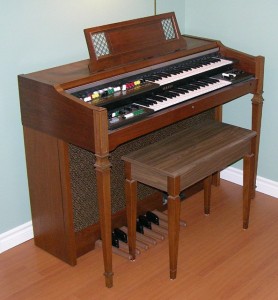
My 1962 Hammond M-111 tonewheel organ, which uses additive synthesis to produce the "Hammond Sound".
Why does the Hammond tonewheel organ (or a good clonewheel) sound like no other electronic organ? What exactly is it that constitutes the “Hammond Sound”?
Many will say that it is the Leslie speaker, with its unsynchronized counter-rotating treble and bass drivers, that produces the sound associated with the Hammond organ. That is probably true to a great extent, since most jazz and gospel music recordings and live performances are done with a Leslie speaker, or a good emulation thereof. A Leslie certainly makes the Hammond sound come alive, and it can do the same for other organs (and even other instruments).
Yet even with no Leslie and no other form of modulation (e.g. Hammond’s unique approach to vibrato), the sound of a Hammond organ is still unmistakable. But why?
I think it is the tonal simplicity and purity of Hammond’s additive synthesis mechanism. Leaving modern digital organs (which either play back samples or mathematically emulate older instruments) out of the picture, electronic organs fall into two broad categories: subtractive and additive synthesis.
In subtractive synthesis, the sound of an organ stop is derived by starting with a waveform rich in harmonics (for example, a sawtooth wave), and then applying carefully (or not so carefully) designed tone filters to alter the relative intensities thereof. Often, the goal is to reproduce the harmonic distribution of a physical instrument such as a clarinet, violin, or a particular kind of pipe in a pipe organ.
Organs using additive synthesis let the musician use drawbars to combine harmonics in varying amounts to produce a complex tone. Technically, each harmonic should be a pure sine wave (the only inherently non-complex tone), and in the Hammond this is very close to true. Some drawbar organs, such as the Vox Continental, produce harmonics that are themselves complex tones instead of true harmonics, so the effect is more like that of combining stops on a subtractive organ.
In theory, both subtractive and additive synthesis can produce the same result. In the former, one starts with everything and takes things away until one is left with the desired sound. In the latter, one starts with nothing and adds things to achieve the desired result. In practice, it’s not feasible to achieve the same results with both methods, and that is the crux of the Hammond sound.
A Hammond organ has nine drawbars per set. One of these is the fundamental (1st harmonic), two are sub-harmonics (tones below the fundamental), and six are harmonics. The available harmonics are the 1st, 2nd, 3rd, 4th, 5th, 6th, and 8th. Because all of the harmonics come from the same tonewheels that generate the fundamental of higher notes, not all of the frequencies are exactly right. Only the 2nd, 4th, and 8th are, while the rest are very slightly sharp or flat. The 7th harmonic is missing because there are no frequencies in the tonewheel generator that are close enough to be used as such. Because of this limited set of harmonics, the resulting sound will be very simple compared to the sounds produced by most physical instruments.

The original image on the left represents a complex tone containing all harmonics. The image in the centre seen through a rose-coloured filter represents subtractive synthesis. The rightmost image attempts to duplicate this by combining a limited number of shades of red.
Subtractive synthesis as used in many other organs usually starts with tones containing all harmonics. So, in addition to the harmonics available on the Hammond, the 7th, 9th, 10th, 11th, and so on are all there. Electronic filtering is used to suppress some of these harmonics to varying degrees. If the filters were both sufficiently precise and absolute, it would be possible to completely eliminate the 7th, 9th, etc., producing a sound almost exactly like that of a Hammond organ. But filters are not that precise or absolute, nor are the designers of subtractive organs trying to emulate a Hammond, so the result is likely to sound more like something that could be produced in the physical world.
That, in my opinion, is what makes a Hammond organ sound the way it does. The Hammond sound is, quite literally, unreal. I’m not a great musician, nor am I a musical or auditory psychologist, so I’m going out on a limb here, but perhaps it is this simplicity of sound that lets the music come through more clearly. This is very much the way I felt the first time I heard Wendy Carlos’ Switched On Bach. That recording allowed me to appreciate the intricacies of the music, instead of losing it in the organized muddle that is an orchestra in a concert hall.
